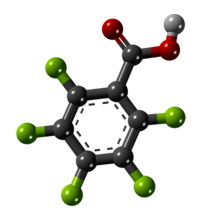
| |

| |
| Names | |
|---|---|
| Preferred IUPAC name Pentafluorobenzoic acid | |
| Other names perfluorobenzoic acid | |
| Identifiers | |
| CAS Number | |
| 3D model (JSmol) | |
| Beilstein Reference | 2054395 |
| ChemSpider | |
| ECHA InfoCard | 100.009.115 |
| Gmelin Reference | 2054395 |
| PubChem CID | |
| UNII | |
| CompTox Dashboard (EPA) | |
InChI
| |
SMILES
| |
| Properties | |
| Chemical formula | C7HF5O2 |
| Molar mass | 212.075 g·mol |
| Appearance | White crystalline powder |
| Density | 1.942 g/cm |
| Melting point | 100–102 °C (212–216 °F; 373–375 K) |
| Boiling point | 220 °C (428 °F; 493 K) |
| Solubility in water | Very soluble |
| log P | 2.06 |
| Acidity (pKa) | 1.60 |
| Hazards | |
| NFPA 704 (fire diamond) |
 |
| Flash point | 87 °C (189 °F; 360 K) |
| Related compounds | |
| Related carboxylic acids | benzoic acids, Nitrobenzoic acids |
| Except where otherwise noted, data are given for materials in their standard state (at 25 °C , 100 kPa). Infobox references | |
Pentafluorobenzoic acid (PFBA) is an organofluorine compound with the formula C6F5CO2H. It is a white crystalline powder that has a high solubility in water. Its pKa of 1.48 indicates that it is a strong acid.
Preparation
Pentafluorobenzoic acid is prepared by treating pentafluorophenyllithium (or pentafluorophenyl Grignard reagent) with carbon dioxide. These reagents are usually prepared in situ from pentafluorobenzene and bromopentafluorobenzene.
It arises via the reaction of perfluorotoluene with trifluoroacetic acid and antimony pentafluoride.
Substitution reactions
Substitution of fluoride occurs typically at the para position. This reaction has been used to anchor the −C6F4CO2H group to surfaces. Magnesium methoxide results in ortho methoxylation. Cleavage of this ether gives tetrafluorosalicylic acid. Via similar ortho-directed reactivity, nickel complexes catalyse the defluoridation of 2 and 5 positions. Without nickel, defluoridation occurs with para-selectivity.
References
- ^ Prakash, G. K. S.; Hu, J. "Pentafluorobenzoic Acid" in e-EROS Encyclopedia of Reagents for Organic Synthesis, 2005. doi:10.1002/047084289X.rn00682
- Harper, R. J. Jr.; Soloski, E. J.; Tamborski, C. (1964). "Reactions of Organometallics with Fluoroaromatic Compounds". J. Org. Chem. 29 (8): 2385. doi:10.1021/jo01031a067.
- Zonov, Yaroslav V.; Karpov, Victor M.; Platonov, Vyacheslav E. (2007). "Transformation of perfluorinated benzocycloalkenes and alkylbenzenes to their carbonyl derivatives under the action of CF3COOH/SbF5". Journal of Fluorine Chemistry. 128 (9): 1058–1064. doi:10.1016/j.jfluchem.2007.05.020.